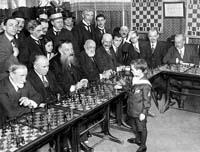Sometimes a player might want to experiment with an unusual opening just for fun, or if he is a intuitive player, he might be able to improvise more effectively than his opponent who is more of a “by-the-book” player.
Another more viable reason might be to use it in tournament play to gain time against an opponent, who because they are more of a theoretician, would lose precious time on their clock as they think of how to take advantage of unorthodox lines.
One of my favorite unconventional openings is the SARAGOSSA or ZARAGOZA OPENING (attributed to José Juncosa of Zaragoza Spain.) 1. c3.... I consider it safer than a lot of “off-beat” openings because you can transpose into a lot of different lines. It’s inherent character is a CARO-KANN in reverse.
1. c3 d5 2. d4 is a Queen Pawn which becomes a COLLE after 2 . . . Nf6 3. Nf3 e6.
1. c3 e5 2. d4 exd4 3. cxd4 d5 is a variation of the QUEEN’S GAMBIT.
1. c3 c5 2. d4 cxd 3. cxd d5 reverts to the exchange variation of the SLAV DEFENSE.
1. c3 c6 2. e4 d5 3. exd cxd 4. d4 the exchange variation of the CARO-KANN.
1. c3 e5 2. e4 Nc6 3. Ng3 the PONZIANI.
Here is a game played by José Juncosa against Znosko-Borovsky using the SARAGOSSA (ZARAGOZA) OPENING:
GROB’S ATTACK (after the Swiss IM Henri Grob, who referred to it as as the SPIKE in his newspaper column, is also known as AHALAUSEN’S OPENING after Carl Ahlhausen (1835–1892) of Berlin,
one of the first to play 1.g4, and KOLIBRI’S OPENING, FRIC’S OPENING (called so in the Czech Republc and Slovakia ) and the GENOA or SAN PIER D'ARENA OPENING, after the city and suburb of Genoa where Tartakower first used and played it in simultaneous exhibitions.
Due to the freakish pawn structure white attains by playing g4 and c4 so early in the game there is frequently little advantage to castling — indeed the king may be safest in the center!
Here is a game using the SPIKE between Henri Grob and Wiedemeier:
The DUNST OPENING (formerly the QUEEN KNIGHT’S OPENING) analyzed extensively by T.A. Dunst a New York master can transpose into the SICILIAN, the CARO-KANN, and the VIENNA. If Black’s reply is 1 . . . d5 and then pushes for 2 . . . d4 after 2. e4, the result is more of a positional type game where White will usually aim for f4.
Some examples of play are as follows:
1. Nc3 Nf6 2. d4 d5 3. Bg5 (In what the Italians have called the “RUY LOPEZ of the Queenside.”)
The DUNST is sound and playable, but affords Black a wide array of defenses.
The PARIS OPENING 1. Nh3 already starts out by by violating the principal of developing the Knight to the center by placing it on the edge of the board. “Knight on the rim, very dim.” The Knight has less mobility and is vulnerable after 1 . . . d5 from attack by Black’s Queen Bishop which could lead to 2 . . . Bxh3.
If Black fails to exploit the Knight development, White may capitalize on the more favorable aspect of the move. Since the Knight on h3 doesn’t block White’s King Bishop Pawn, that Pawn may effectively advance to f4, attack the adverse center and open white’s King Bishop file.
Here's an example of the PARIS OPENING:
As long as we’re moving the Knight to the rim, one particular opening I used years ago with some success was 1. Na3 - the DURKIN ATTACK. R.T Durkin has done surprising well with this in various postal and New Jersey tournaments and T.A. Dunst has brought off a few successful experiments, however, apart from the shock value, the DURKIN ATTACK does not make a reliable weapon. The DURKIN is also referred to as the SODIUM ATTACK, which comes from the algebraic notation 1.Na3, as Na is the chemical symbol for the element sodium. Here is a game played by Robert T. Durkin against NM Jim West
The POLISH OPENING is also known as the ORANG-UTAN and the SOKOLSKY. It begins with 1. b4 and was added to opening repertoire by Viennese Master Englisch. It was a favorite of Tartakower, one of the first prominent players to play it, had accepted Polish citizenship after Poland gained its independence after World War I - although he had been born in Russia, and lived in Paris. He played it once at New York 1924, calling it the ORANG-UTAN in honor of Suzy, an orangutan he had met at the Bronx Zoo. Pachman advocates the reply 1....a5 giving the opening a rather odd appearance.
Spassky played 1.d4 b5 in the 22nd game of his 1966 world championship match against Petrosian, when Spassky was desperate for a win. It didn't work.
The obvious defects of the POLISH are that it initiates a wing demonstration when emphasis should be placed on center control and provides a ready-made target which may linger as a permanent sore-spot for White. On the other hand, the move readies a promising fianchetto, while the advanced pawn will inhibit enemy expansion on the Queenside. So, basically the opening appeals to those who like to take uncharted courses but serves no purpose where there is a preference for sounder and more conservative methods.
Here is a game between Alexey Sokolsky and Strugatsch using the POLISH OPENING.
So, whether you just want to shake-up your opponent by catching hm/her off guard with on of these “off-beat” openings, or wade into the “Black and White Jungle” (as Kasparov put it to Josh Waitzkin) with an adventurous nature and “devil-may-care attitude” - it might make for some entertaining games.
Here is a recent game I played in December 2012 using the SARAGOSSA /ZARAGOZA (1. c3)
